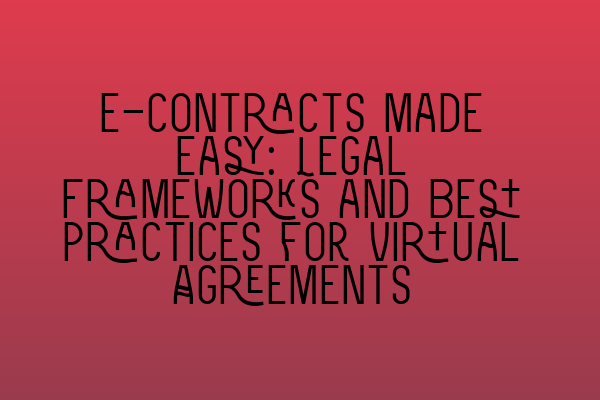E-contracts Made Easy: Legal Frameworks and Best Practices for Virtual Agreements
Welcome to our blog post on making e-contracts easy! In today’s digital age, the use of electronic contracts, or e-contracts, has become increasingly prevalent. As more and more businesses conduct their operations online, understanding the legal frameworks and best practices for virtual agreements is crucial. In this post, we will explore the legal aspects of e-contracts, discuss their advantages and challenges, and provide practical tips for creating and enforcing these agreements.
Understanding E-contracts and their Legal Frameworks
An e-contract refers to a contract formed and executed electronically. These contracts are given legal recognition and enforceability under various legal frameworks, such as the Electronic Signatures in Global and National Commerce Act (ESIGN Act) in the United States and the Electronic Communications Act 2000 in the United Kingdom. These laws establish that e-contracts have the same legal validity as traditional paper contracts, as long as certain requirements are met.
To ensure the enforceability of e-contracts, it is essential to comply with the legal requirements specified by these frameworks, such as obtaining valid electronic signatures, maintaining accurate electronic records, and ensuring the accessibility and integrity of the contract. Adhering to these guidelines not only ensures legal compliance but also enhances the efficiency and convenience of the contract formation process.
The Advantages and Challenges of E-contracts
E-contracts offer numerous advantages over traditional paper contracts. Firstly, they allow for seamless and expedited contract formation, eliminating the need for physical document exchange and reducing administrative burdens. Additionally, e-contracts offer increased accessibility and convenience since they can be signed and accessed from anywhere with an internet connection. This allows businesses to engage in international transactions more efficiently, without the limitations of physical proximity.
However, along with the benefits, there are challenges associated with e-contracts. One significant challenge is ensuring the security and authenticity of electronic signatures to prevent fraud or unauthorized access. Implementing strong encryption measures, multi-factor authentication, and utilizing trusted e-signature platforms can help mitigate these risks. Furthermore, it is crucial to address the issue of jurisdiction and governing law in e-contracts, particularly when dealing with international transactions, to ensure clarity and avoid potential conflicts.
Best Practices for Creating and Enforcing E-contracts
When creating e-contracts, it is essential to follow best practices to ensure their enforceability and protect your interests. Here are some practical tips:
- Clearly outline the terms and conditions: Clearly define the rights and obligations of the parties involved in the contract. Use precise language and avoid ambiguity to minimize the risk of misinterpretation.
- Incorporate applicable laws and jurisdiction clauses: Include provisions regarding the governing law and jurisdiction to provide clarity in case of disputes. Consider consulting with legal professionals to ensure these provisions align with the intended objectives of the contract.
- Use reputable e-signature platforms: Utilize trusted e-signature platforms that comply with legal requirements and provide robust security measures. This ensures the authenticity and integrity of electronic signatures.
- Maintain accurate records: Keep thorough and accurate records of the e-contracts, including any amendments or modifications made during the contract lifecycle. These records serve as evidence in case of disputes or legal challenges.
- Regularly review and update e-contract templates: As technology and business practices evolve, it is crucial to review and update your e-contract templates to align with legal requirements and industry best practices. Staying up to date ensures that your contracts remain valid and enforceable.
For a more comprehensive understanding of contractual obligations, you may want to read our related article on Exploring the Impact of Frustration on Contractual Obligations: Legal Insights. Additionally, if you are interested in interpreting contractual clauses and understanding their hidden meanings, you can check out our article on Interpreting Contractual Clauses: Unlocking the Hidden Meanings.
Entrepreneurs will find our article on the Legal Aspects of Business Contracts: Key Considerations for Entrepreneurs highly informative, as it explores the legal considerations specific to their role. Moreover, if you want to gain a deeper understanding of different types of agreements in contract law, you might be interested in reading Agreements in Contract Law: Understanding Its Various Types.
Finally, if you are interested in understanding the basis of contractual exchange, our article on the Essentials of Consideration: Understanding the Basis of Contractual Exchange provides valuable insights.
In conclusion, e-contracts have become an essential part of modern business transactions. Understanding the legal frameworks and best practices for virtual agreements is vital for both businesses and individuals engaging in online contracts. By adhering to the legal requirements, addressing challenges, and following best practices, you can create enforceable and secure e-contracts that streamline your operations and protect your interests.
